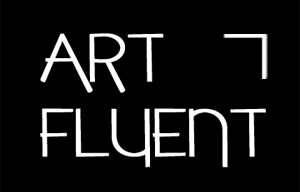
The Designer, digital photocollage
-Corinne, we'd love to hear your story and how you got to where you are today, both personally and as an artist.
I grew up in Montana. I saw the Northern Lights bloom across the sky. I loved walking where Lewis and Clark had. I slept in the backyard and watched the sky. When I was 7, I dragged a loose horse home and kept him in the backyard in case he was lost. The artist Charlie Russell lived where I grew up. I opened the doors in his house, turning the doorknobs he had turned.
My family camped in Glacier Park. One morning Mom made a lavish bacon and eggs breakfast on a camp stove. We sat at a picnic table. A Black bear cruised into the camp. We grabbed the beagle and dove into our 1962 Ford station wagon. Gramma (whose grandmother had crossed the plains on foot) sat calmly eating, in a dress, while the bear finished off all the food on the table except hers.
This is where my art comes from.
I rarely make a picture set indoors. I like how the outdoors can speak in a picture. An animal can take the place of a person and perhaps say more. An owl on a scooter can be evocative. Don’t get me started on flying saucers.
I keep an idea notebook beside my bed. I found myself jotting ideas down when hiking this week. Examples:
Dilemma or miracle?
If anything goes wrong, blame the pig.
A more rational day than the last.
Burning person beside burning stump
Candy whale!
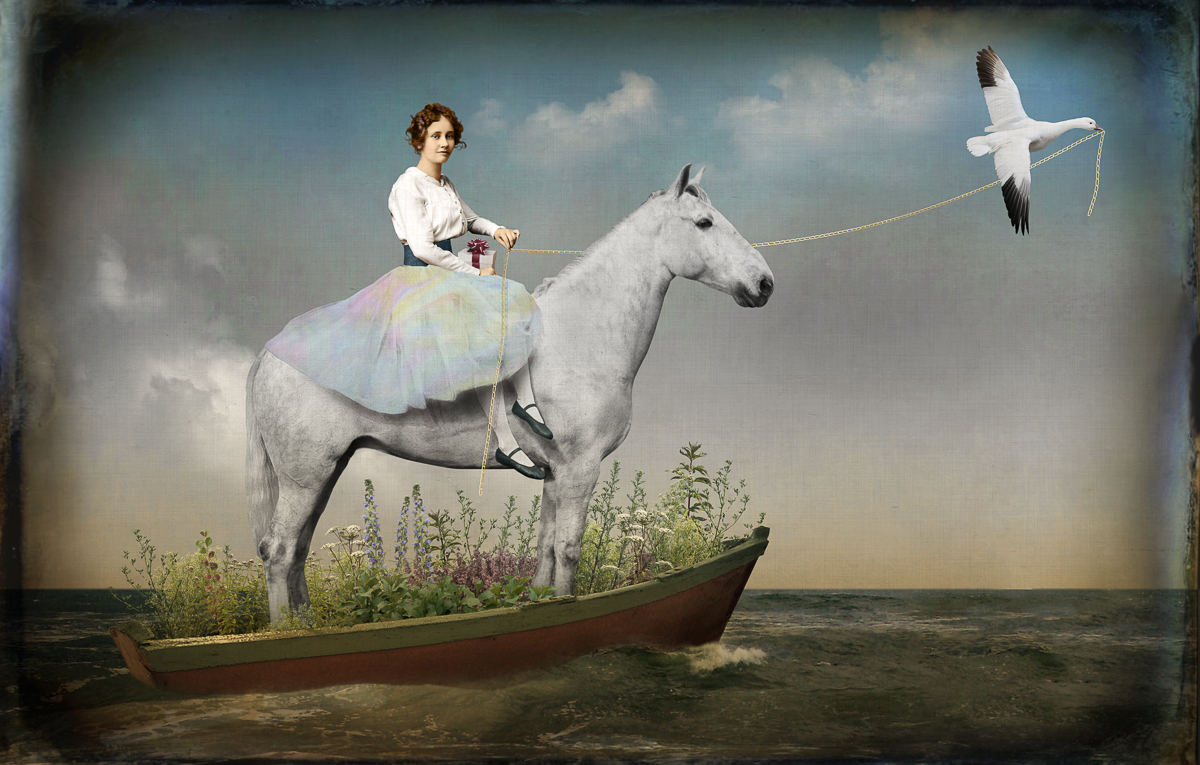
Emissary, digital photocollage
-Your work beautifully blends historical imagery with modern digital tools. How do you balance those two worlds, and what do you find most rewarding about that contrast?
A picture might have bits from a 17th century painting, a photo of a porcupine I took with a digital camera last summer, a carved temple decoration my husband photographed in Hong Kong with a film camera in 1973, and an 1890’s photo of a great-grandfather. It’s impossible stretches like these combos that give my work vitality.
I find it fascinating to put warring ingredients into a picture and somehow get them to bury the hatchet. I take all colors out and repaint others back in, change lighting and the shapes of things, add texture and shadows….a picture takes 6 weeks.
I like Photoshop. I feel like I’m sitting at a massive theater organ with stops for the grumble of a bear and the sound of a forest fire, a crank for thunder, foot pedals for time travel and a keyboard for upholstery, yo-yos, unicorns and mastodons.
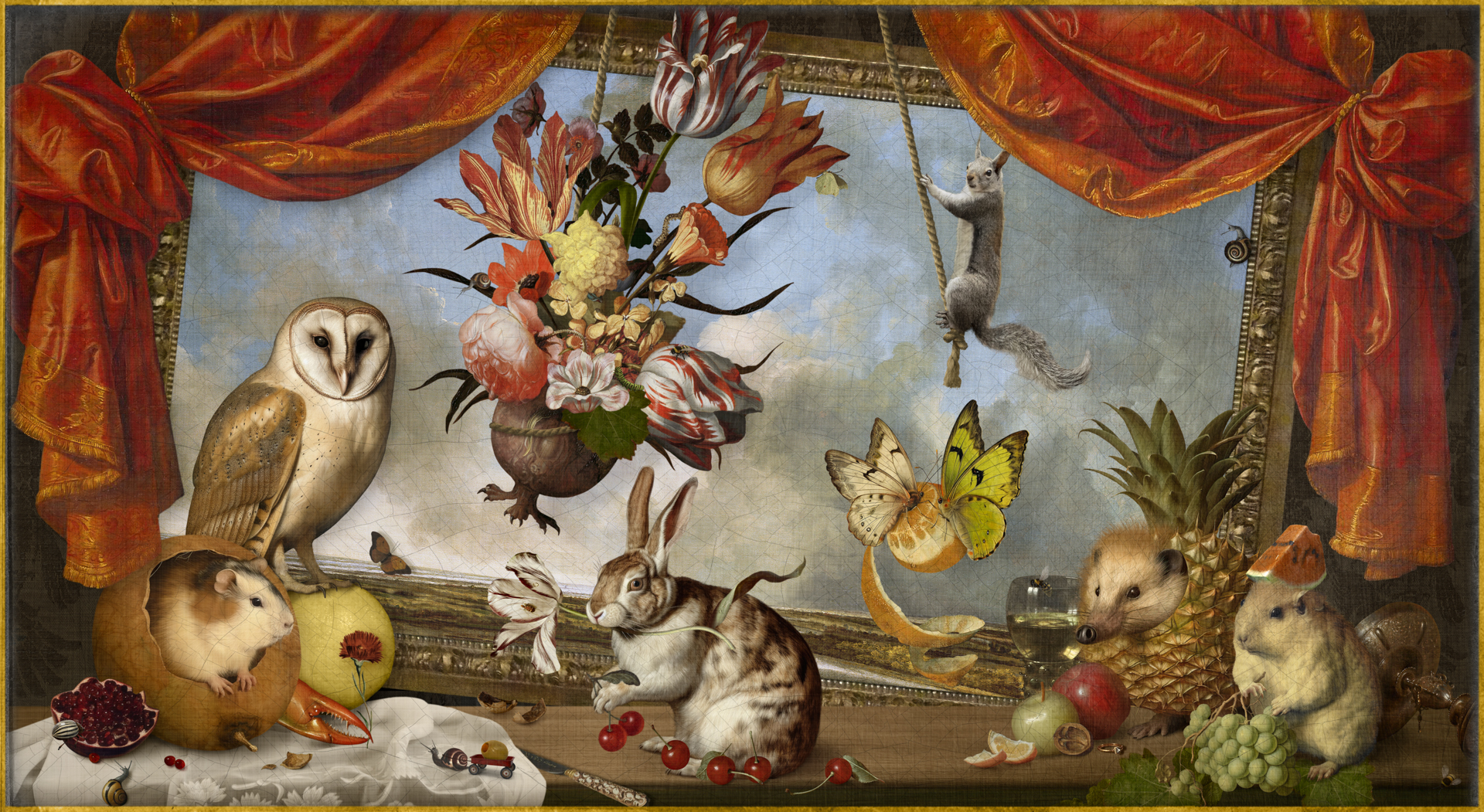
Still Life Takedown, digital photocollage
-What inspires you most during your creative process— is it the technology you work with, the historical imagery, or the conceptual ideas that emerge?
The ideas intrigue and drive me most.
Here’s my recipe.
Start with an arresting photo of a person or an animal, possibly a lake or a sofa. Take it out of its original photo and put it on a clean white background. You can move it all around because it’s on a separate layer. This is Thing One.
Add ingredients using the Yikes Method: add in something else you’ve been thinking about. If it doesn’t play well with Thing One, YIKES, take it out. If it works, leave it in. Now you have Thing Two.
Repeat many times. The more Things you have, it will be increasingly difficult to add another. By this time, the Things have a relationship that ideas will emerge from.
Make separate pictures for each idea and work on all of them simultaneously. Choose the best one and finesse it to completion.

Might As Well Dance, digital photocollage
-You mention a ‘packrat’s nest’ of curiosity, humor, fear, and absurdity. How do you weave these emotions to maintain a cohesive yet surreal narrative while still keeping everything feeling connected?
I am a psychologist’s daughter. I grew up with his Rorschach set. The ink blots are abstract, but they're like starter fluid, as far as stories go.
If I were a juggler I’d have just two balls. One would be story telling; the other would be form (form being shapes, composition, colors, all that).
Because of the time I spent with these tests in a closet with a flashlight in my formative years, it’s easy for me to flip from psychological story to form and back while I’m working. While I’m working, I’m juggling.
I like to go for a psychological twist.
Past pictures have been about thrill-seeking, hilarity, rescue, wonder, finding yourself, disaster, vanity, absurdity. All the things. Just like life.
In life, things fly by and away so fast. Good things, bad things. Art is a way of slowing things down to get a good look. I want my work to resonate with people and remind them how truly marvelous their time on the planet is.
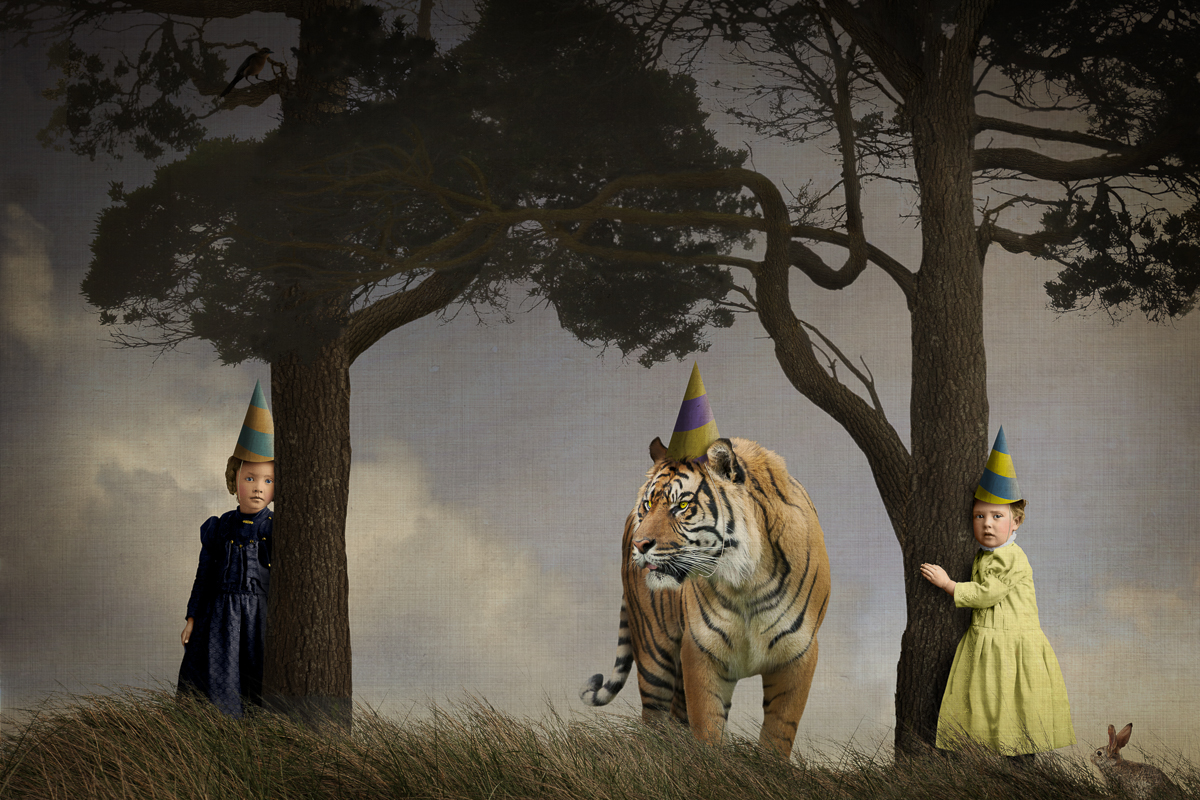
Party Game, digital photocollage
-What’s the best way for someone to check out your work and provide support?
You can see my work in person at Meyer Gallery in Park City UT, Gebert Contemporary in Scottsdale AZ and Phillips Gallery in Salt Lake City, UT.
Please visit my work on my website www.corinnegeertsen.com
You’ll be able to see work in progress and my newest on Instagram @corinnegeertsen
I’m enormously excited, delighted and entertained while I’m working. I hope you have the same experience while looking.
Statement
I assemble my works digitally from photos of my ancestors and from my expanding archive of over 75,000 photos.
I’m on a constant photographic scavenger hunt, outfitting ancestors with backdrops, sidekicks and belongings.
I print my work myself in small editions on archival photo paper with pigment inks.
My images are quirky visual narratives about psychological predicaments. I especially like a good plight.
My art leans toward surrealism, as it has odd juxtapositions, non-sequiturs, and an element of surprise.
My work content mirrors personal, political and global situations– in a sly way.
My work is a packrat’s nest of things that are deeply a part of being alive: curiosity, humor, fear, rescue, individuality, absurdity.
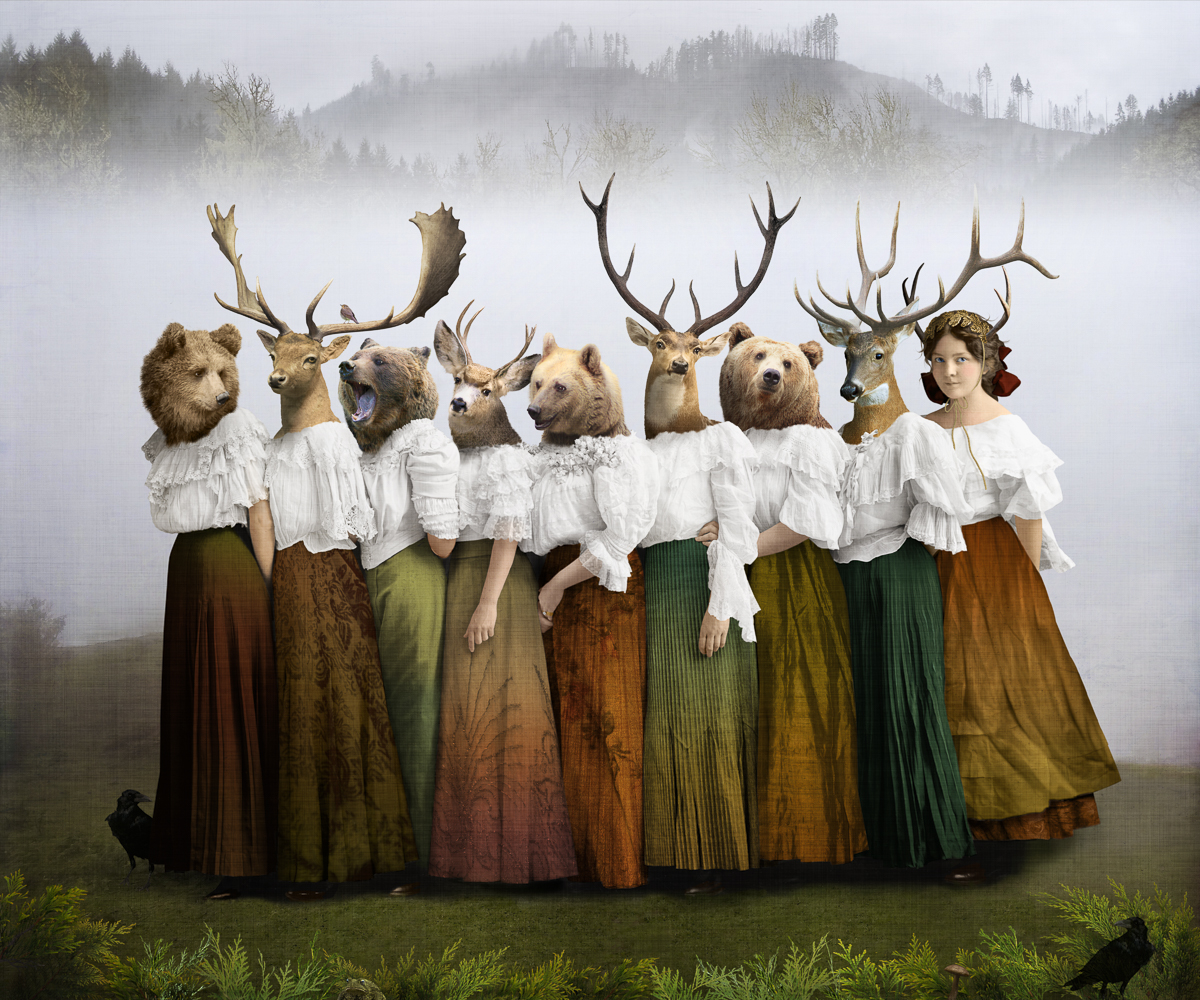
Founding Members of the Wildlife Society, digital photocollage
Bio
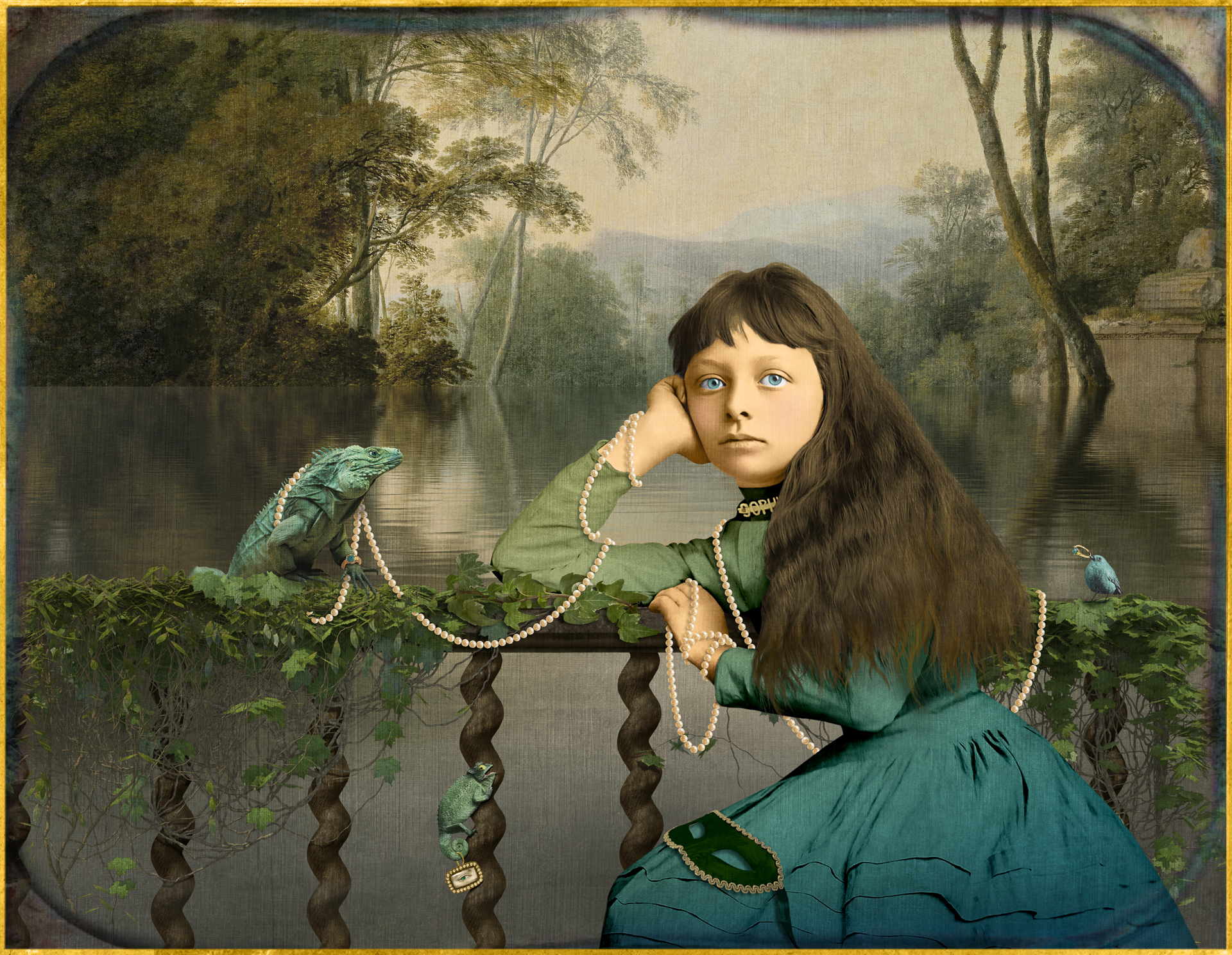
After the Heist, digital photocollage
I grew up on the plains of Montana, where I developed an affinity for strong horizon lines and big skies. I always drew.
My father was a psychologist. He would show someone a set of dramatic pictures and ask them to make up a story about each picture. I spent a lot of time with these picture plates, fascinated by the ties between stories and images. As a result, I move easily between story line and image and back again, nuancing my work with psychological twists.
I studied drawing and painting at Brigham Young University where I acquired a B.A. and an M.F.A. in drawing and painting. Photoshop and digital art did not yet exist.
Much later I took a Photoshop course to restore old family photos. Two weeks into the class I began seeing my ancestors as characters in dramas. Photoshop matches the way I think- when I first found Photoshop, I felt I had discovered the other half of the map.
My work spans a century and a half of technology. I use Civil War and Victorian era studio portraits as source material, and work digitally on a computer with massive memory, deep within the technical intricacies of Photoshop. I enjoy the contrast of working with multiple technologies.
I currently live and work in Mesa, Arizona.
